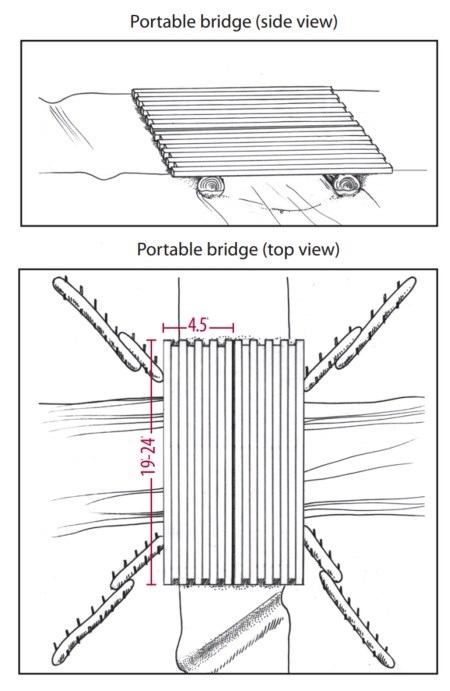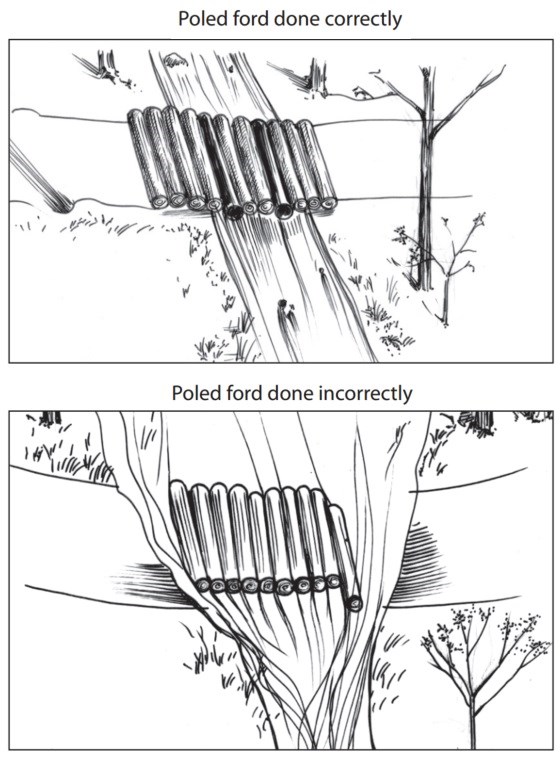Stream Crossings for Forest Operations

Description
Studies in Massachusetts have shown that stream crossings during forestry operations represent one of the principal ways that sediment can enter a waterbody. Stream crossings are usually necessary on the majority of forest operations. The objective of this BMP is to provide a stable means of transporting forest vehicles and timber across streams under both temporary and permanent conditions. Reducing erosion, sedimentation, and turbidity are the water quality goals of this BMP.
The Massachusetts Forest Cutting Practices Act (MGL Chapter 132) has specific requirements for both temporary and permanent stream crossings during forestry operations.
- When a stream crossing is required, existing old crossings must be rehabilitated and used, provided that it can be shown that this will cause less disturbance than constructing a new crossing.
- Temporary crossing structures must be removed at the end of the operation, and the site must be stabilized.
- Installation of permanent stream crossings and the construction of permanent roads involving fill through wetland resource areas requires the approval of the local Conservation Commission under the Wetlands Protection Act MGL 131 section 40 with the filing of a Notice of Intent.
- The rehabilitation, new construction, and stabilization of stream crossings must be designed to the specifications defined below.
| BANKS | STREAMBED | ACCEPTABLE CROSSING METHOD |
Shallow
(less than one foot in height) | rocky
soft | Ford with stabilized approaches, corduroy, culvert, bridge
Corduroy, bridge, corduroy with culvert |
Steep
(greater than one foot in height) | rocky
soft | Corduroy, culvert, bridge
Corduroy, culvert, bridge |
Other stream crossing requirements include

- All crossing will be made at right angles to the channel.
- When crossing involves fill or other closed or semi-closed structures that will obstruct flow, the structures must be designed to accommodate at least the 25-year storm.
- If a culvert is to be used, the Forest Cutting Plan must state the diameter of the culvert
- All banks and approaches to stream crossings require stabilization during and at the end of the operation.
- All stream crossings should be accurately mapped and labeled on the Forest Cutting Plan map. Markings on the ground with paint or flagging at the time the Plan is filed is also required.
- If a stream crossing must be changed during the operation, the DCR Service Forester must be notified and approve the change before it is made.
- Within 1000 feet upstream of a public water supply reservoir, measured along the course of the stream from the high water mark of the reservoir, all stream crossings must use a temporary bridge. Exceptions to this will require filing of an Environmental Notification form (ENF) in accordance with MGL Chapter 30, sections 61-62H and CMR 11.00.
Stream Crossing Options
The Massachusetts Forest Cutting Practices Act (MGL Chapter 132) specifies the following requirements for both temporary and permanent stream crossings during forestry operations. Three types of crossings are allowed: corduroy or poled ford; bridges; and culverts.
Corduroy, or Poled Ford
Corduroy, or Poled Ford Logs are placed in a stream parallel to the direction of flow. Logs should be large enough to keep the skidder out of the water, and should be level with the stream banks. Culverts are then placed in and amongst the logs, to permit streamflow though the ford, and prevent damming. Ductile iron culverts or pieces of gas pipeline can be used since they can support heavy logging equipment without collapsing.
Bridges
Bridges function the best to keep forest machinery out of the water and to prevent sediment from being dragged into the stream from tires and the logs themselves. Bridges also help to keep stream banks intact.
There are two ways to bridge a stream: build a skid- der bridge onsite using logs and wooded planking, or construct a re-usable temporary skidder bridge of lumber bolted together. This joined lumber can be lifted into place to cross a stream and then removed when the timber harvesting is completed.
Culverts
Culverts can be used to cross a stream for forestry operations but they must be sized according to the amount of drainage area upgradient from the crossing. For details on the use of culverts in forestry operations in Massachusetts see the Skid Trails, Logging Roads and Landings Fact Sheet.
Hay bales are also required to stabilize the stream banks where crossing will occur. Silt fences can also be used however they should never be placed directly in the stream. New erosion control products such as turf-reinforced mats ( TRMs) can also be placed prior to and after stream crossings to help stabilize the soil and prevent erosion and sedimentation. Seeding following the harvesting operations and removal of temporary bridges is also required.
References
Kittredge Jr., D. B. and M. Parker. 1995. Massachusetts Forestry Best Management Practices Manual. MADEP and USEPA-Region 1, Water Division, Water Quality Section.
MADEP. 2001. The Massachusetts Unpaved Roads BMP Manual. Project 98-06/319. USDA. 2002. Massachusetts Forest Resource Fact Sheet. Northeastern Area - State and Private Forestry.
USEPA. 1993. Polluted Runoff (Nonpoint Source Pollution): Guidance Specifying Management Measures for Sources of Nonpoint Pollution in Coastal Waters. EPA-840-B-93-001c. Office of Wetlands, Oceans, and Watersheds. http://www.epa.gov/owow/nps/MMGI
USEPA. 1995. Polluted Runoff (Nonpoint Source Pollution): Planning Considerations for Roads, Highways, and Bridges. EPA-841-F-95-008b. Office of Water.